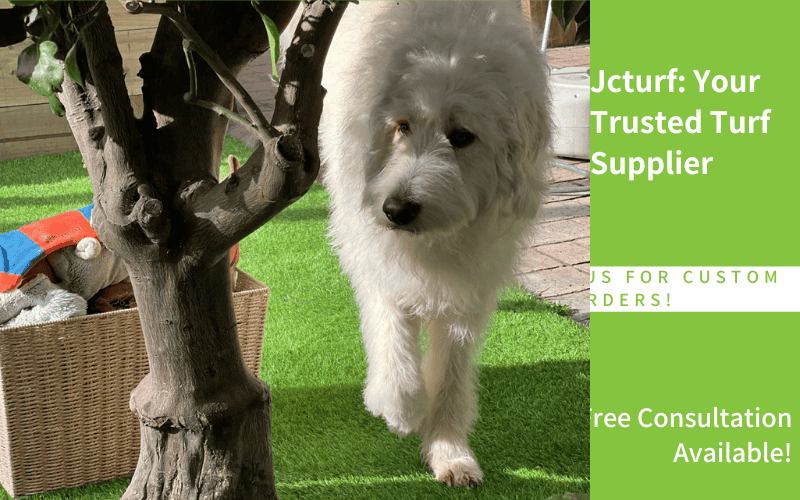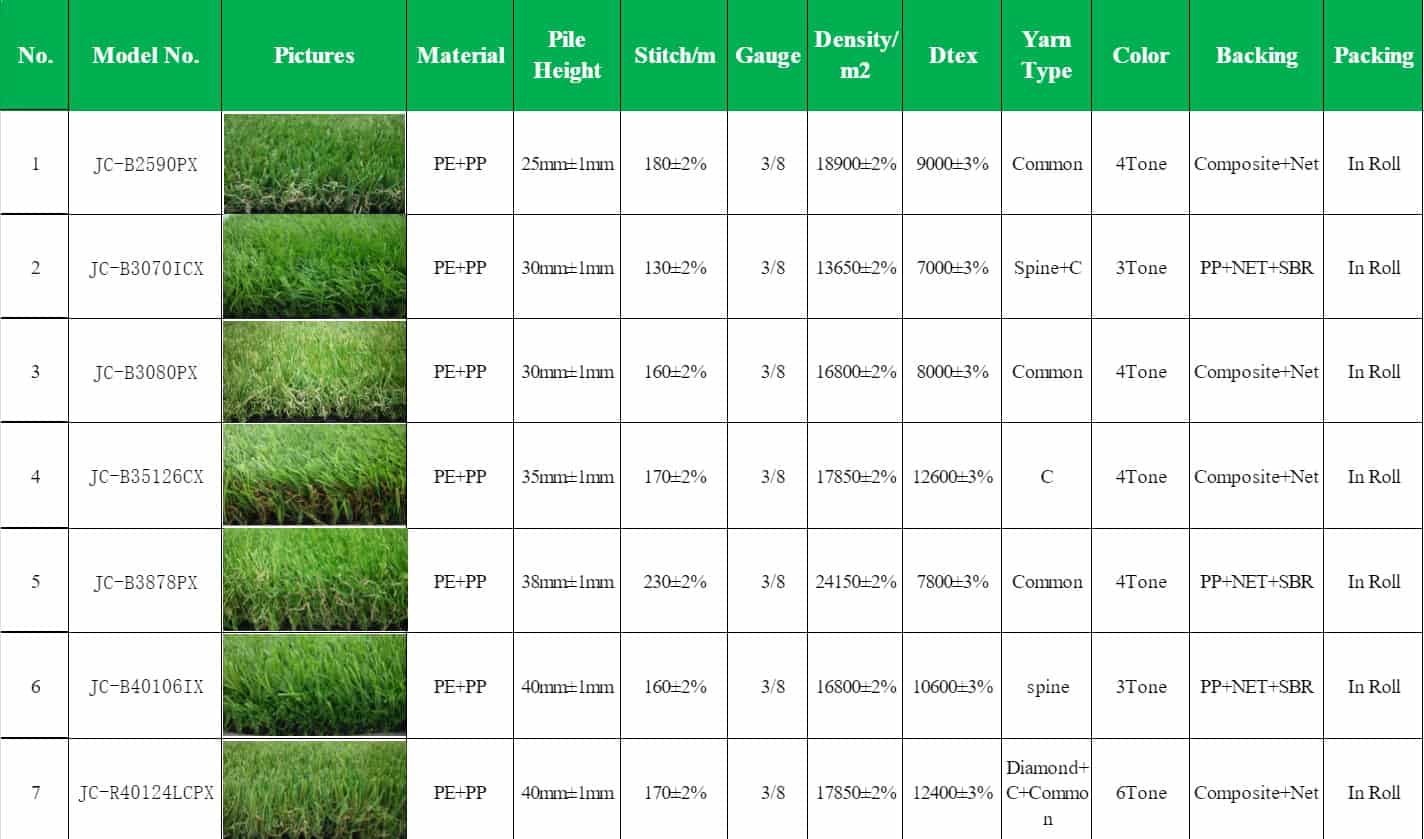Let’s be honest — natural grass isn’t designed for dogs. If you’re dealing with muddy paw prints, patchy lawns, or lingering smells, you’re not alone. That’s why more dog owners are switching to artificial grass. But is it really worth it?
In this guide, we’ll cover the real pros of turf for pet homes — from cleaner floors, less damage, and lower maintenance to better looks and fewer pests. Then we’ll dive into the downsides, like odor buildup, surface heat, and cleaning needs. We’ll also look at safety, how to choose the right turf for dogs, what our customers say, and how to keep it clean. If you’re wondering whether turf can actually make life better for you and your dog — this article will help you decide.
Top Pros of Artificial Grass for Dog Owners
Artificial grass for dogs comes with more benefits than most people expect. In this section, we’ll cover the top reasons why pet owners choose synthetic turf — from keeping your home clean to preventing lawn damage, saving time on maintenance, and even reducing pests.
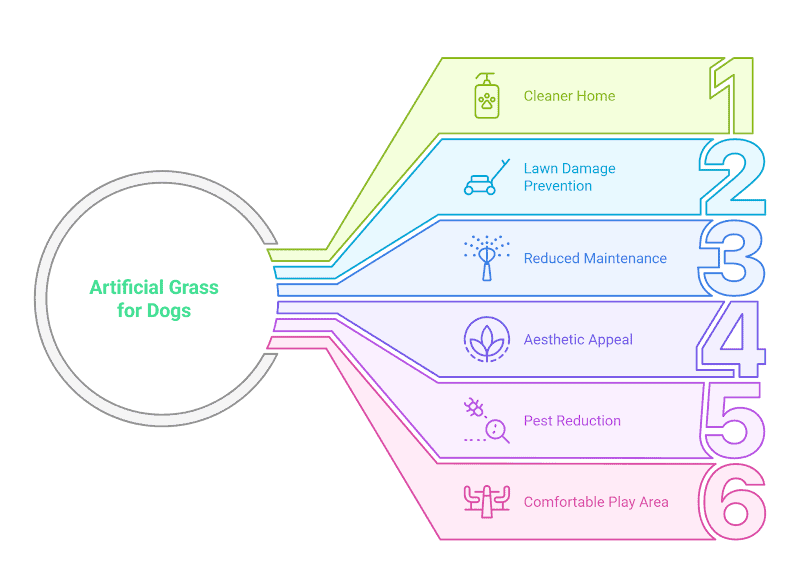
No More Muddy Paws or Dirt Indoors
If you’re tired of mopping the floor every time your dog comes in, this is the biggest win. Synthetic turf eliminates bare patches, mud puddles, and loose soil. That means fewer paw prints, no grass clippings on your couch, and less dirt stuck between your dog’s toes. You simply get a cleaner home—every day, rain or shine.
Stops Lawn Damage from Digging and Running
Natural grass can’t take the stress of zoomies and digging, especially with big dogs. Artificial turf offers a stable, durable surface that stands up to rough play without forming bald spots or holes. No reseeding. No patch repairs. Just a lawn that looks fresh, no matter how hard your dog plays.
No Watering, Mowing, or Harsh Chemicals
Once installed, artificial grass requires far less maintenance than natural grass — no mowing, no watering, and no weeding. You also won’t need to use chemical fertilizers or herbicides, which is better for your dog’s health. For many owners, that means more freedom on weekends — and one less thing to worry about.
Year-Round Green and Aesthetic Appeal
Turf stays lush and green regardless of weather, shade, or foot traffic. Even during winter or drought, your yard will look neat and inviting. It’s not just functional — it actually improves your curb appeal. Many dog owners say it makes their backyard feel more livable again.
Fewer Ticks and Fleas
Artificial turf greatly reduces the kind of moist, shady environments where ticks and fleas thrive. No real grass means fewer hiding spots. Some owners even noticed fewer vet visits for flea-related skin issues after switching to turf. That’s one more reason dogs — and their humans — feel better outside.
Comfortable Play Area — If You Plan It Right
Artificial turf can get warm under the sun, but with the right setup, it becomes a safe and comfortable play zone for your dog. Shade sails, misting systems, or choosing a lighter-colored turf can help reduce surface heat. Many of our customers say their dogs now enjoy being outside more often — without worrying about mud or overheating.
Real Drawbacks of Artificial Grass with Dogs
Artificial grass for dogs isn’t perfect. It comes with real downsides you should know before installing — from odor buildup to heat retention, maintenance demands, upfront cost, and even chewing or digging issues. Let’s take a closer look at the challenges you might face.
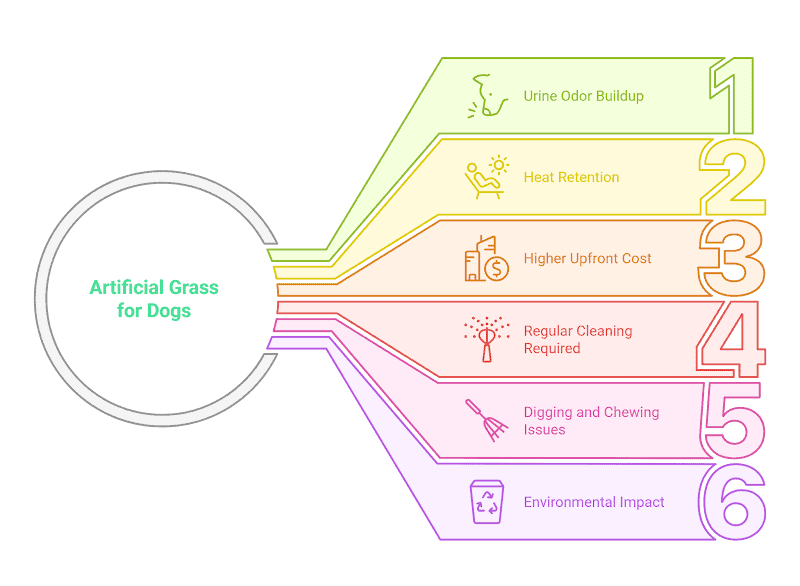
Urine Odor Buildup
Unlike soil, artificial turf doesn’t absorb urine — it traps it between the fibers and the base. If not rinsed regularly, the smell can become overwhelming, especially in warm weather. Some owners describe it as “baked-in ammonia” during summer. Enzyme cleaners can help, but without a solid cleaning routine, odor is a serious concern.
Turf Gets Hot in the Sun
Artificial grass heats up fast under direct sunlight. On hot days, the surface can become too hot for your dog’s paws — even hotter than concrete in some cases. While shade structures and water misting can reduce this effect, it’s something to plan for, especially in warmer climates.
Higher Upfront Cost
Quality dog-friendly turf isn’t cheap. Between turf, infill, drainage base, and installation, costs can be several times higher than laying natural sod. And while the long-term savings are real, the initial price tag often surprises first-time buyers.
Still Needs Regular Cleaning
Many assume artificial grass is “set and forget.” That’s not true with pets. You’ll need to remove solid waste, hose it down often, and apply cleaners to prevent odor. It’s less work than maintaining a real lawn, but not maintenance-free — especially in multi-dog households.
Dogs May Try to Dig or Chew
A few dogs with anxious or high-energy behavior may react to turf by digging or chewing, especially if the installation is loose or seams are exposed. This isn’t common, but it can happen. If your dog tends to destroy toys or furniture, you’ll want to choose a turf with reinforced edges and install it securely.
Not Biodegradable or Easily Recycled
Most artificial grass products are made of plastics that don’t break down naturally. At the end of its lifespan, turf often ends up in a landfill. If sustainability is a concern for you, this is something to weigh before investing.
Is Artificial Grass Safe for Dogs?
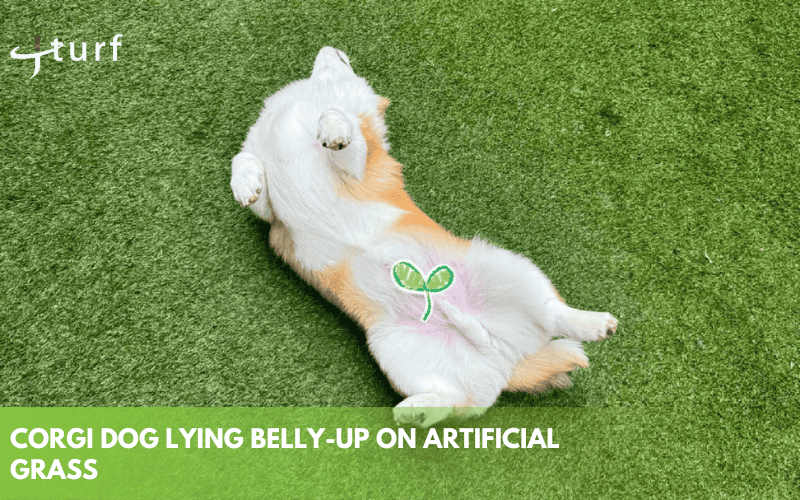
Yes — artificial grass can be safe for dogs, as long as you choose the right product and use it properly. Safety depends on several factors, including what the turf is made of, how hot it gets, and how your dog interacts with it.
Start with the materials. Look for pet-friendly turf that’s free from lead, heavy metals, and PFAS (so-called “forever chemicals”). Many cheaper products use recycled plastic fillers or adhesives that aren’t tested for pets. Reputable suppliers will clearly state if their turf is certified non-toxic.
Next, consider heat. Artificial grass can retain heat, especially in full sun. On hot days, it may feel uncomfortable — or even unsafe — for your dog’s paws. This isn’t a chemical risk, but a thermal one. That’s why many owners add shade sails, plant trees, or simply limit outdoor time during peak heat.
Ingestion is another concern. Dogs that chew obsessively might try to bite off turf fibers or infill particles. While most turf won’t harm a dog in small amounts, repeated chewing isn’t ideal. Good installation — with seams hidden and edges secured — can prevent this, and supervision always helps.
Finally, think about comfort. Some dogs are sensitive to rough surfaces, especially if the blades are stiff or the infill is too coarse. High-quality turf designed for pets usually includes softer blades and better drainage, which reduces skin irritation and odor buildup.
In short: synthetic grass isn’t dangerous by default — but not all turf is made equal. To keep your dog safe, choose certified pet turf, avoid cheap fillers, install it well, and pay attention to how your dog responds. With the right setup, artificial grass can be both safe and enjoyable for your pet.
How to Choose the Right Turf If You Have Dogs
Not all artificial grass is made with pets in mind. If you’re choosing turf for a home with dogs, you’ll need to look beyond color and texture. In this section, we’ll walk through the five most important things to consider — from drainage and softness to odor control and durability — so you can pick the right turf the first time.
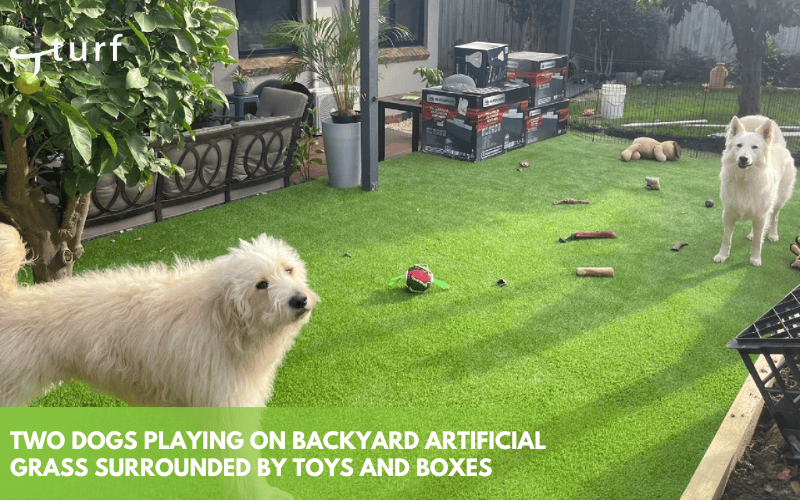
Prioritize Fast Drainage
Dog urine won’t absorb into turf — it needs to flow through quickly. That means drainage is a top priority. Look for turf with perforated or fully porous backing that allows liquids to pass through into the base layer. If water sits on the surface or soaks into the infill, odors and bacteria build up fast. A well-draining turf system is the foundation of a clean, odor-free yard.
Choose Pet-Safe, Non-Toxic Materials
Avoid low-cost turf with recycled fillers or unknown chemicals. Stick to products clearly labeled pet-safe or certified non-toxic. Some infill types — like crumb rubber — are best avoided, as they tend to retain heat and may contain chemical residues. When in doubt, ask for safety test data from the supplier.
Pick a Turf That’s Comfortable Under Paws
Your dog will be running, rolling, or lying on the turf every day. Rough or overly stiff blades can irritate skin or paw pads, especially for short-haired breeds. Go for turf with medium-length, soft blades and avoid overly dense products with tough thatch. Some pet owners test samples barefoot — if it feels too scratchy for you, it’s too much for your dog.
Avoid Turf That Overheats Easily
Even good turf can get hot, but some materials hold more heat than others. If you live in a sunny area, choose lighter-colored grass and avoid thick, dark infill like black rubber. Some turf systems are now designed with heat-reflective technology — look for terms like “cool yarn” or “low heat retention.” Combined with shade or misters, this makes outdoor time safer in summer.
Think About Daily Maintenance Needs
Turf with shorter pile height is easier to scoop and clean. Look for antimicrobial backing and odor-resistant materials. Check if the turf traps debris or resists rinsing — especially if you have more than one dog. The easier it is to clean, the more likely you’ll stick to a regular routine.
What Our Customers Say: Real-World Turf with Dogs
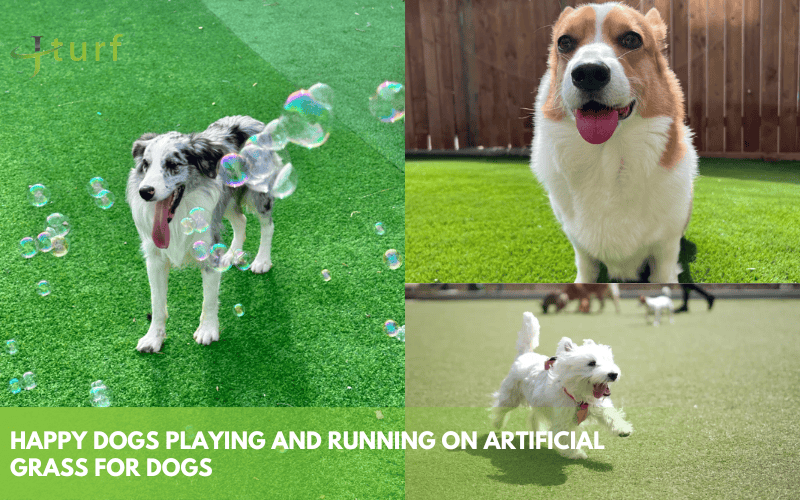
Many of our customers first came to us with the same doubts: Will artificial grass smell? Will it get too hot? Will my dog destroy it? After months or even years of use, their answers speak for themselves.
One family with two large dogs told us they used to deal with mud constantly. Every rainy day meant dirty floors and endless mopping. “Now we can let the dogs out without thinking twice. The turf drains fast, and our house stays clean.” This kind of relief is something we hear often.
Another customer in Texas was worried about heat. “It gets brutal here in summer. But once we add a simple sunshade over the turf and hose it down in the afternoon, it stays cool enough for our German Shepherd to relax outside.” Solutions like these help make the product work year-round.
We’ve also had feedback from owners with more sensitive dogs. One shared: “Our beagle used to scratch constantly on natural grass — allergies, probably. Since switching to turf, she barely itches. That alone was worth it for us.”
Maintenance is a recurring topic. Customers admit it’s not 100% hands-off, but say it’s far easier than dealing with dying grass or muddy patches. “I rinse once a week and scoop daily. Compared to replanting grass every spring? No contest.”
The most common thread? Less stress. A cleaner yard. Fewer surprises. “It’s not perfect,” one client wrote, “but it made our yard feel usable again — for us and our dogs.”
How to Clean Artificial Grass Used by Dogs
Keeping your artificial turf clean is the key to avoiding odors and stains. If your dog uses the turf daily, it needs regular care — but it doesn’t have to be complicated. In this section, we’ll walk through the basic steps: picking up waste, rinsing, applying odor control, and doing deeper cleaning when needed. Here’s how to keep your lawn looking and smelling fresh.
Remove Solid Waste Daily
Always start by picking up any solid waste. Use a plastic scoop or rake — just like you would on natural grass. Don’t leave it overnight. Leftover residue can get ground into the blades, attract flies, and become harder to clean later. For multiple-dog homes, scooping once in the morning and once at night is ideal.
Rinse the Turf Regularly
After picking up solids, rinse the turf with a garden hose. Focus on the areas your dog uses most often. This helps flush away urine residue before it builds up. In warm months or with larger dogs, rinsing every 1–2 days is best. Make sure your turf has good drainage — otherwise, water will pool and odors will stick around.
Use Enzyme-Based Odor Removers
Water alone won’t eliminate smells. Use a pet-safe enzymatic cleaner designed for artificial turf. These products break down ammonia compounds in urine, which are the main cause of bad odors. Spray lightly over affected areas, wait 5–10 minutes, then rinse thoroughly with water. Choose formulas that are non-toxic, biodegradable, and labeled for outdoor turf use.
Do a Deep Clean Once a Month
Even with regular rinsing, grime and bacteria can build up over time. Once a month, do a deep clean: use a turf broom to loosen debris, then apply cleaner over a larger area. A hose-end sprayer makes it easier to apply cleaner evenly across larger turf sections. In high-use zones, you can gently scrub the blades with a soft brush to lift embedded residue.
Prevent Buildup with Good Habits
The easiest cleaning is the one you don’t have to do. Keep nearby plants trimmed to reduce leaf drop. Discourage your dog from using the same exact spot every time — urine concentration leads to stronger smells. If possible, rinse quickly after accidents, especially in hot weather. Good habits make long-term upkeep easier and less frequent.
Is Artificial Grass Worth It If You Own a Dog?
If you’re tired of muddy floors, torn-up grass, or daily lawn repairs, then yes — artificial turf is worth it. It costs more upfront, but it gives you a cleaner yard, fewer problems, and a space your dog can actually enjoy all year.
It’s not maintenance-free, but it’s far less work than patching dead grass or dealing with constant mess. For homes with active dogs, small yards, or extreme weather, turf often pays for itself in peace of mind.
It won’t be right for everyone. But for many, it’s the upgrade that finally makes their yard usable again.
Most of our customers come to us with doubts — and stay with turf because it makes everyday life easier. If you’re considering the switch, we’re here to help you choose the right product and layout for your dog, your yard, and your lifestyle.
We Get It. Mud, Smell, and That Spot Your Dog Always Chooses.
Some days it feels like your dog owns the yard — and you’re just there to clean up after it. Muddy paws, patchy grass, and that one corner that always smells a little too strong. You love your dog, but your lawn’s had enough.
That’s where we come in. At Jcturf, we make pet turf that’s actually built for pets. Our anti-mat yarns bounce back after zoomies, and our pet-proof drainage backing clears moisture before smells can set in — even after long-term digging, scratching, and sun.
We test everything in over 15 years: wear, odor, UV, comfort — and it shows. It won’t fade easily, won’t trap lingering smells, and avoids the crusty, stiff spots that real grass leaves behind.
If you’re ready to give your dog a yard that works — and reclaim your weekend — let’s talk turf.

